- Home
- Penelope Lively
Consequences Page 2
Consequences Read online
Page 2
When they drove out into the country in her father’s Rover, she eyed the street upon street of little houses in which other lives happened, of which she knew nothing, and she wondered. So she was privileged, she was among those who were to be envied. But she could not feel enviable or grateful; some part of her protested, was critical and hostile and…difficult. It was as though she had some alter ego who told her she did not belong here. But she had never known anywhere else, and where else could there be?
She began to question the most sacred assumptions. Why must some people be poor? Why do I have to wear stockings, and gloves? Why are men’s and women’s lives different? Why must I go to the Langfords’ dance tonight? Her mother sighed and shook her head. Her father folded his newspaper, stared at her, and said he hoped she wasn’t becoming a silly little socialist. Her brothers laughed and patted her on the head and went about their business.
Lorna and her mother were permanently at odds. Lorna sat sullenly in a corner throughout a debutant tea party; her mother said that she was ashamed of her, she had let everyone down. She declined a dinner invitation from a red-faced young man who had pawed her in a taxi, and who talked of nothing but horse racing; her mother observed that the young man’s father owned a thousand acres in Gloucestershire. She was silent and rebellious at dress fittings; she read a book when cousins were visiting; she went off on her own and did not tell her mother where she was going. There were heated exchanges; doors were slammed.
And thus it was that on an exquisite June morning Lorna sat weeping on a bench in St. James’s Park, with the willows cascading into the lake, and a cohort of bright-feathered ducks eddying about at her feet. She became aware that she was not alone on this seat, looked sideways, stopped crying, and the rest of her life began.
When Matt was young he did not know where London was. The word was familiar; you heard it on the wireless or in conversation, that thumping sound—London. It meant Big Ben and the Houses of Parliament, and solders in red coats and crazy black hats; the King and Queen lived there; its people talked Cockney. His parents had never been to London, nor indeed had anyone he knew. The place was an irrelevance, for those living in a small market town close to the Welsh border. Matt’s father was a local government official; his interests were sternly focused and his horizons parochial. He had been born in the town and had never seen any reason to stray farther than Chester, for an annual dinner from which he returned with a sigh of relief. Matt’s mother came from a village three miles from the town, to which she had moved when she was a girl to work at the Town Hall, where David Faraday was a junior functionary. The family joke was that they had courted beside the tea urn, which accounted for Mary’s addiction to tea.
When Matt was sixteen he learned where London was. By the time he was seventeen he knew that he had to go there, not on a visit but for a long time. This knowledge sprang from several years of communion with Mr. Lavery, the art master at the grammar school, who was his mentor and friend. The words “art college” fell from Mr. Lavery’s lips when the two of them were standing before Matt’s pen and wash drawing of a landscape beyond the town, a piece of work that even Matt—a modest lad—could see was pretty good. “What is an art college?” he asked.
Mr. Lavery told him, and the seeds were sown.
A year later, he said to Mr. Lavery, “What is a wood engraving? How is it done?” He had in his hand a book that he had bought for a shilling in the secondhand bookshop on the High Street: Erewhon by Samuel Butler, with wood engravings by Robert Gibbings.
It was not the text that had appealed to him, but the illustrations, at which he had gazed with fascination.
Mr. Lavery explained. Matt said that he wished he could have a go himself. Mr. Lavery explained further: wood engraving is a sophisticated and highly technical form of graphic art, dependent on an expensive material—boxwood—and alas, not really appropriate for the curriculum of a school art department. He talked further about art colleges.
Bryony, Matt’s elder sister, was going to be a teacher. She, too, had achieved grammar school, the girls’ institution on the other side of town, and had excelled. She was the pride of her parents, and was spoken of approvingly among the neighbours; education was highly regarded in those parts and at that time. Bryony would go to teacher training college in Chester; her mother worried about the evils of metropolitan life but felt that Bryony had the strength of character to cope. She was a serious and rather taciturn girl; she and Matt found less and less to say to each other as they grew older, and cohabited in a kind of amiable boredom.
Art had stolen up upon Matt. It fingered him when he was quite young, he later realized, remembering an infant passion for pencils and paper, and later endeavors with sticks and stones and leaves and seeds and berries that could be turned into intricate sculptural arrangements upon the garden path. He had always wanted to make things. Not the mechanical constructions of model airplanes or meccano but things that demanded original materials, flair, and ingenuity. He had found a seam of clay in a field beyond the town and made little sculptures, which he tried to fire in his mother’s oven, to her distress. He discovered the possibilities of papier-mâché, using glue and newspaper, and created an elaborate bas-relief of Theseus and the Minotaur, inspired by the primary school’s Book of Myths and Legends. He requested crayons and paints for Christmas and birthday presents, and scrounged paper from rubbish bins and local shops. And then when he arrived at the grammar school there was that fertile ground of the Art Room, and the heady encouragement of Mr. Lavery. He borrowed books on art from the town library and pored over the Italian Renaissance, French classicism, Rembrandt, Turner, Constable, the Impressionists. He was long familiar with the town’s small art gallery, which held the work of several local nineteenth-century painters and not much else; now he was amazed by these revelations of exalted practice. So this was what art could do.
He became Mr. Lavery’s special project, with license to haunt the Art Room in free periods and after school. Mr. Lavery wore a corduroy jacket with leather-patched elbows, smoked Woodbines, and lived alone in a terrace cottage on the edge of town. A small exhibition of his work at the school had caused some consternation among parents, who had been anticipating a few peaceable watercolors. Mr. Lavery was into Vorticism. The parents toured the exhibition, tight-lipped, and hoped to one another that he was not teaching the boys this sort of thing.
They need not have worried. By and large, their sons were not remotely concerned with art; art periods were regarded as intervals of light relief, when you let off steam. Mr. Lavery was prepared for this; he maintained a kind of order by way of laconic wit at the boys’ expense. They recognized him as a maverick form of adult, whose opinions and behavior hinted at worlds with which they were unfamiliar, and were accordingly wary or contemptuous, depending on temperament. Either way, they did not care to provoke his ironic comments, and tempered their behavior; mostly, they just made it clear by their halfhearted application that they had better things to do than mess about with this sort of stuff.
Except for Matt. He realized early on that if he was going to persist with his unorthodox commitment he would have to learn to ride out the derision of his peers. The few boys in the school with a serious commitment to music had the same problem. The esteemed activities here were cricket, rugby, and athletics. Matt was fortunate in that he was robustly built. Those inclined to torment him as an arty-farty came to recognize someone who did not care much about what others said in any case, and who was likely to give as good as he got if it came to a dustup. In time, Matt was allowed to go his own way, somewhat solitary but not unpopular, seen simply as an eccentric, but a person to be reckoned with.
Mr. Lavery was astute enough not to pay too much overt attention to Matt. Matt’s work was in a class of its own; he knew this, and Matt knew that he knew it, and to make too much of that would have done Matt no good. His tutorship of Matt became a personal matter, pursued in the privacy of the Art Room out of hours. Here, he
kept Matt supplied with materials, suggested new directions, criticized and encouraged, and when Matt was seventeen Mr. Lavery began to speak of art colleges.
At first, David and Mary Faraday were dubious. They appreciated that Matt had evident talent—were proud, indeed—but the notion of formal training in this area was foreign to them. His father could not see what it would lead to, and wondered about work prospects. His mother shied violently at the notion of London.
“But why would you have to go there?”
“Because that’s where the best colleges are. Mr. Lavery says so. He says Liverpool or Chester wouldn’t do. Mr. Lavery says it’s the Grosvenor School of Modern Art I should aim for, in London.”
The image of London presented itself, as the family sat around the supper table. Bryony saw the King and Queen receiving her brother on the balcony of Buckingham Palace, and was irritated. Matt saw an immense light-filled studio in which students stood before easels, and an elevated version of Mr. Lavery cruised among them. His mother saw streets lined with women of ill-repute, and blanched.
His father saw expense, and said so.
“Mr. Lavery says I could get a scholarship. He says he’ll write letters for me. He wants to talk it over with you.”
And thus Mr. Lavery’s cautiously floated proposal took shape, blossomed, generated much correspondence, the selection of a portfolio of Matt’s work and, eventually, a trip to London for Matt, his portfolio under his arm and many instructions from his parents and Mr. Lavery in an envelope in his pocket.
He was amazed by the place—by its size, its dirt, its streaming impervious crowds of people—but he was too fraught about the task in hand to pay more than superficial attention. He must now expose his work to people who were accustomed only to the best. To do so felt both presumptuous and exhilarating; at one moment he was unbearably diffident, at another excitingly assured. “Just be yourself,” his parents had said, won over at last by Mr. Lavery and the contemplation of Matt’s evident promise. But who was he? A schoolboy from the sticks? An aspiring artist? Both. And also a person whom he sensed but still hardly recognized—a maturing self who had conviction and opinions and boundless determination. He would get this scholarship; he would go to London, he would be an artist, come what may.
When the letter from the Grosvenor School came, and he read it out to the family, his mother sat stricken and speechless; the women of ill-repute were right there in the room now, leering. Matt’s father said, “Well done, son.” Bryony, impressed despite herself, looked at her schoolboy brother and decided that this was perhaps a person of some account. She recognized that art has a certain cachet, and realized with private chagrin that those drawings and paintings that Matt had from time to time allowed the family to see must, after all, be the real thing, or, at least, some eery accessory to the real thing. She gave Matt a kindly cuff on the shoulder, and said she hoped he wasn’t going to get all uppity now. His mother rallied, faced down those lurking women, and began to talk anxiously of clothes, equipment, and sheltered accommodation.
Matt was by nature buoyant, but he now experienced a wild exhilaration, a sense that he had not before known, soaring above the exigencies of daily life. He could hardly believe his good fortune. And yet at the same time he knew that he had been right in that kernel of self-belief he had always had, that Mr. Lavery had been right in his support, and that he could join his peers in that imagined studio, knowing that he was as good as they were, and perhaps better than some. But, beyond and above all that, he savored the knowledge that, miraculously, his life was now on course. He was licensed to do exactly that which he wanted to do, for the next three years at least. After that—well, after that would be up to him, but for the foreseeable future he could spend each and every day doing what he liked best: he could draw, he could paint, he would learn wood engraving.
All this came to pass, not as he had imagined it, partly because reality never conforms to expectations but also because he himself became a subtly different being. The London at which he had gawped in amazement on that first visit became a familiar element through which he moved with ease; he learned how to manipulate the city, how to live cheap, how to use it. And the art college itself, at first a bewildering experience of alien attitudes and assumptions, of astonishing license, of people who spoke differently, dressed differently, lived differently, became within months a natural habitat, and he a distant older relative of the boy who had arrived there, and had placed himself nervously before an easel on that first morning.
Matt grew up. He shot through several years in each of the first months, or so it seemed. He felt as though he was some hatching insect, the dragonfly bursting free. He had friends, he had a mattress on the floor of a much-occupied attic, above all he had uninhibited access to a studio and to practicing artists who encouraged and criticized. He worked in pubs and bars to pay for paints and materials—the art college supplied only a certain amount. He sold some work shown in a student exhibition. And, above all, he became an engraver.
From the moment that he first placed a block on the sandbag and made the initial tentative lines with the graver, he knew that that intuition had been right: this was his medium. He could not have said exactly why; it had to do with the complexity of the process, the way in which what you first saw and drew—that image of a real scene—must be passed from one material to another, from the sketch pad to the tracing paper to the block and thence eventually to its final form, the subtle and delicate arrangement of black and white that was the finished print. But it had to do also with the way in which the fortuitous shapes and patterns of the physical world—trees, water, sky, buildings—were transformed by hand and eye into something that reflected what you saw but had now become a creation in its own right: the engraving was a dazzling black-and-white complement to the world of color.
Wood engraving thrived right now. He pored over the work of his eminent older contemporaries—Eric Gill, Robert Gibbings, Edward Wadsworth, Gertrude Hermes, Blair Hughes-Stanton—and sat at the feet of his own distinguished teacher, Iain Macnab. He learned the possibilities of the form, the potential; he saw how each artist makes of it something different, something new. He thought: I can do this.
And the time was ripe. There was a demand for the work of a promising engraver. At a party after the college’s annual student show, in his last year there, Matt met Lucas Talbot, a man a few years older than himself who earned a tenuous living as a fine press publisher. The Heron Press operated from Lucas’s dilapidated Victorian house in Fulham; he invited Matt to visit, and acquaintance blossomed into friendship. Lucas was, in a sense, everything that Matt was not; he was awkward, shy, socially inept, alarmed by women. Matt had been at the hub of student activity at the college, talked easily to anyone, was sexually confident. They liked one another immensely. Lucas knew that Matt was already a fine engraver, and that he would soar. Matt admired Lucas’s ferocious dedication to the creation of handsome editions. Within weeks Lucas had commissioned Matt to work on a series that he planned on English topography.
“W-w-which do you fancy?” he asked—the stammer always surfacing at moments of diffidence or excitement, “Moors and mountains or estuaries and waterways?”
Matt hesitated, unaware that the rest of his life hung in the balance. “Um…I don’t really mind, either sounds good…Oh, let’s say estuaries and waterways.”
“Done,” said Lucas. “Would thirty guineas for the twelve prints be all right? I’m afraid I can’t manage any more.”
Matt, for whom this would be comparative riches, said that this would be fine. Between them, they began to plan the structure of the book and the subject matter of Matt’s engravings.
In the interests of which, on that June morning, he selected a bench in St. James’s Park, put his sketch pad on his knee, took some stale bread from his pocket, and thus invited the fates to smile upon him.
The cottage stood beside a lane. At the front, it looked out over the high hedge bank of its garden,
across the lane and the sloping field beyond to a wooded valley that reached up into the Brendon hills. Behind, fields and copses rolled away down to the Bristol channel coastline; there was a long thin slice of pewter sea and, on a clear day, the distant shore of Wales. Square and squat, cob and thatch, dug solid into the red Somerset earth, the small building had seen out generations of farm laborers. People had been born here, died here, had heard rumors of wars, had achieved the vote, had sweated over the same patch of landscape and stared at the same sky. Now, the place stood empty, bar the mice and the black beetles and the spiders. Empty, and two pounds a month.
Matt and Lorna stepped gingerly inside. The place smelled of damp, and two centuries of wood smoke, and a faint suggestion of the dead jackdaw that had fallen down the chimney and lay on the hearth, a brittle carcass. Matt picked it up and carried it out. He threw it into the hedge and stood for a moment, noting the view of the hills. He saw the roof of a house in the valley, with smoke curling up from a chimney; he saw stooked corn in a field: he saw the distant dotted shapes of sheep. He saw pattern and structure; pictures began to form in his head.
He went back into the cottage and joined Lorna on a tour of inspection. There was one main room on the ground floor, into which the front door opened directly; an open fireplace with a blackened kitchen range, a stone sink. Another, smaller room led off this, with a window that looked out onto the long triangular garden. Shaggy grass, gooseberry bushes, apple trees, and a plot that remembered vegetable gardening, with some stumps of cabbage and a tangle of long-rotted beans.
“It’s the Marie-Celeste,” said Matt. “Where did everybody go?” There was a built-in dresser in the main room, empty but for a cracked cup, a child’s rusted tin top, a moth-eaten tea cosy.

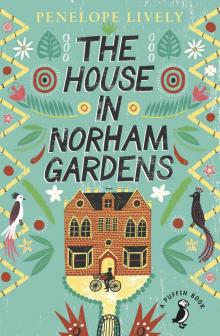 The House in Norham Gardens
The House in Norham Gardens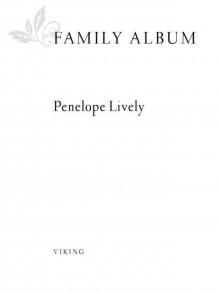 Family Album
Family Album Life in the Garden
Life in the Garden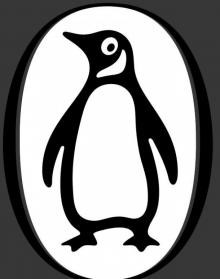 Oleander, Jacaranda: A Childhood Perceived
Oleander, Jacaranda: A Childhood Perceived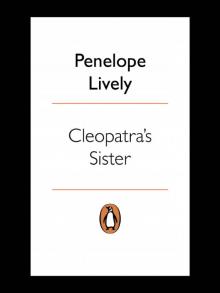 Cleopatra's Sister
Cleopatra's Sister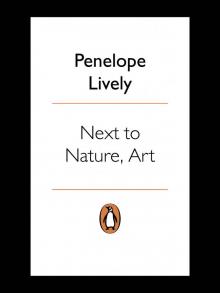 Next to Nature, Art
Next to Nature, Art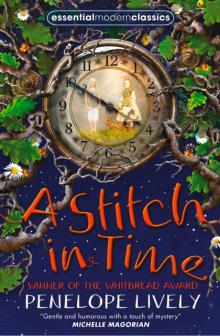 A Stitch in Time
A Stitch in Time Moon Tiger
Moon Tiger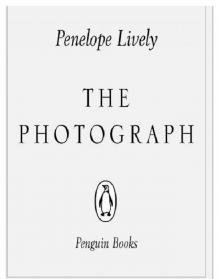 The Photograph
The Photograph Heat Wave
Heat Wave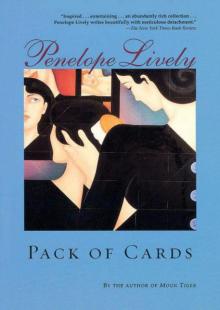 Pack of Cards
Pack of Cards Spiderweb
Spiderweb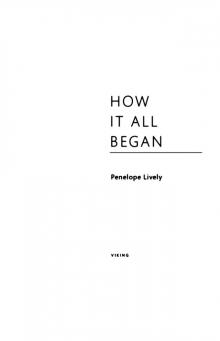 How It All Began
How It All Began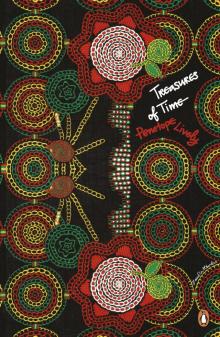 Treasures of Time
Treasures of Time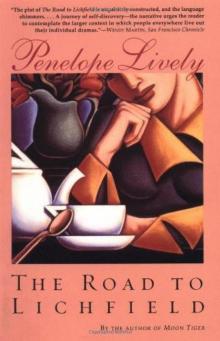 The Road to Lichfield
The Road to Lichfield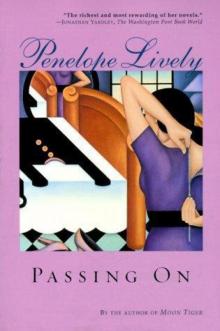 Passing On
Passing On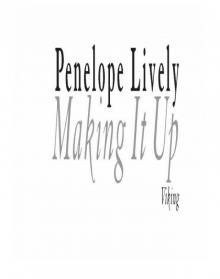 Making It Up
Making It Up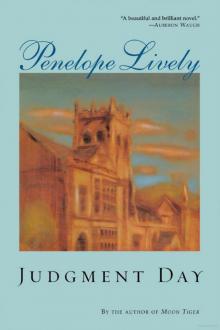 Judgment Day
Judgment Day The Purple Swamp Hen and Other Stories
The Purple Swamp Hen and Other Stories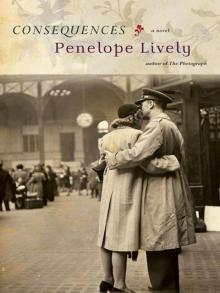 Consequences
Consequences *****Passing On*****
*****Passing On*****